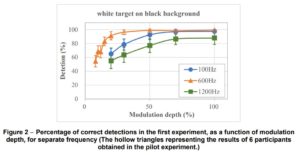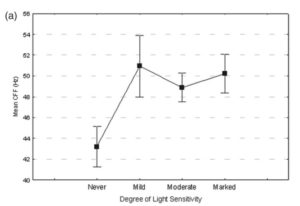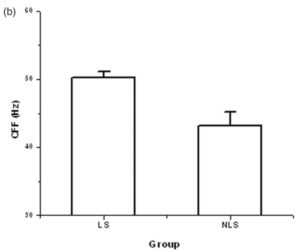Here is select research and articles about the human effects of flickering lights.
It’s not just you: Christmas lights look different now, and can give you headaches: NPR Short Wave podcast created December 2023. A very solid primer on the problems of LED flicker. The guest host on the show was Naomi Miller, PNNL lighting scientist.
Perceiving without seeing: How light resets your internal clock, a current (12-17-22) article from NPR talking about how humans and other life have photoreceptive cells other than the well-understood rods and cones that are responsible for many things including circadian rhythm, temperature control, migraine pain and other areas. The article refers to “melanopsin” and is also referred to as ipRGC, (Intrinsically photosensitive retinal ganglion cells). This is important because it brings to light that there is a poorly understood channel where light information reaches the brain.
Flicker: A Review of Temporal Light Modulation Stimulus, Responses, and Measures August 16, 2022, (local archive) An excellent, very in-depth scientific literature review on the subject of flickering lights, temporal light modulation, and the phantom array effect by Naomi Miller et al.:
A Review of the Literature on Light Flicker: Ergonomics, Biological Attributes, Potential Health Effects, and Methods in Which Some LED Lighting May Introduce Flicker. According to this IEEE research paper released in 2010, “The effects of flicker can range from decreased visual performance to non-specific malaise to the onset of some forms of epilepsy.” It goes on to report that photosensitive epilepsy is comparatively rare (about 1 in 4,000 people) but less obvious effects like eye strain, reduced visual performance and headaches are common.
Concerns in the Age of the LED_ Temporal Light Artifacts by Joe Wood, Illuminating Engineering Society (via) Excellent primer with background and terminology definitions.
Designing to Mitigate the Effects of Flicker in LED Lighting. 2014 article in IEEE Power Electronics Magazine.
LED Lighting Flicker and Potential Health Concerns: IEEE Standard PAR1789 Update. A 2010 IEEE Standards Working Group document detailing the problems with flickering lighting.
The Impact of Flicker From Fluorescent Lighting on Well-Being, Performance and Physiological Arousal. A study showing how old magnetic ballast fluorescent lighting causes many problems compared to electronically ballasted fluorescent lighting. Old fluorescent lighting has a flicker very similar to cheap modern LED lighting.
Fluorescent Lighting, Headaches and Eyestrain by Wilkins AJ, Nimmo-Smith I, Slater AI, Bedocs L. Lighting Research and Technology, 1989. Research describing how magnetically ballasted fluorescent lights in the 1980’s caused lots of headaches. New LED’s have similar waveform!
Photo-metric Flicker in Computer Displays Back-Light and a Method for Reduction of its Human Health Effects. A paper describing problems and solutions with the flicker in backlit computer displays.
How Flashing Lights and Pink Noise Might Banish Alzheimer’s, Improve Memory and More. 2018 Nature article reviewing some astounding findings about the potentially powerful effects of flickering lights on the brain.
Flicker Performance in LED Lighting. A white paper with some background, includes a useful chart comparing flicker percentage and flicker frequency against observability.
Stroboscopic effect: contrast threshold function and dependence on illumination level. 2018 research article in Journal of the Optical Society of America
The Visibility of the Phantom Array Effect Under Office Lighting Conditions points out that the phantom array effect is almost imperceptible with a black target on a white background. But with a white target on a black background, the phantom array effect is easily seen! Subjects were sensitive to 100-1,200 Hz flicker but most sensitive to 600 Hz flicker, where they could detect the presence of the effect with almost 100% accuracy with a modulation depth of just 25%.

Critical flicker frequency and related symptoms in mild traumatic brain injury describes how a person’s CCF (the frequency at which they notice that a light is flickering) is related to the reported degree of light and motion sensitivity. And people with mild TBIs that reported light sensitivity had, on average, a significantly higher CCF frequency
in individuals with mild TBI.
My Phone is Making me Sick and I’m Not Alone – An article on androidcentral.com where the author describes how PWM sensitivity caused by smart phone display flickering is a real problem.
No, Theraspecs and the FL-41 tint doesn’t help with flicker, but they used to! Read the article or my summary:
Arnold Wilkins is a vision professor and scientist. In the early 1990’s he came up with the “famous” FL-41 tint to solve a specific fluorescent lighting problem. It filtered out some of the more flickery colors of the fluorescent bulbs that were made at the time. This did a good job of reducing apparent flicker, reducing eye strain, headaches, nausea, etc. This is the tint that Theraspecs prominently promotes as being beneficial. However, such fluorescent tubes haven’t been used in 20+ years, so the specific colors it blocks aren’t relevant at all.

